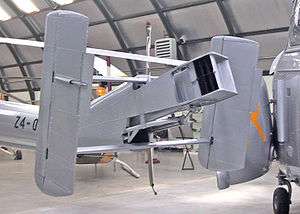Aerotécnica AC-14






The Aerotécnica AC-14 was a Spanish five-seat light helicopter of the 1950s, designed by Jean Cantinieau, based on enlarging his Nord Norelfe design.
The AC-14 continued the Cantinieau practice of mounting the engine forward of the main rotor, and like the Norelfe, used the ducted exhaust from the turboshaft to counter the torque of the main rotor at low speeds, while at high speeds the exhaust gases were deflected rearwards to increase speed, torque being compensated for by movable twin tail fins.[1]
The first of prototype flew on 16 July 1957.[1] A pre-production order for ten machines was placed by the Spanish Air Force where they served for a short time under the designation EC-XZ-4. No full production ensued, as they were much more expensive than the second hand Bell 47G-2 and G-3.
Operators
-
 Spain
Spain
- Spanish Air Force - Ten pre-production aircraft only.
Specifications
Data from Janes' All The World's Aircraft 1961–62[1]
General characteristics
- Crew: 1
- Capacity: 4 passengers
- Length: 8.13 m (26 ft 8 in)
- Height: 3.10 m (10 ft 2 in)
- Empty weight: 650 kg (1,433 lb)
- Gross weight: 1,250 kg (2,756 lb)
- Max takeoff weight: 1,350 kg (2,976 lb)
- Powerplant: 1 × Turbomeca Artouste IIB , 300 kW (400 hp)
- Main rotor diameter: 9.65 m (31 ft 8 in)
- Main rotor area: 72.35 m2 (778.8 sq ft)
Performance
- Maximum speed: 180 km/h (112 mph; 97 kn)
- Cruising speed: 150 km/h (93 mph; 81 kn)
- Range: 300 km (186 mi; 162 nmi)
- Ferry range: 640 km (398 mi; 346 nmi) (with auxiliary tanks)
- Service ceiling: 6,800 m (22,310 ft)
- Rate of climb: 6.99 m/s (1,375 ft/min)
Related content
Related development: Nord Norelfe
Comparable aircraft:
Designation sequence: AC-11 - AC-12 - AC-13 - AC-14 - AC-21
References
- Taylor, Michael J. H. (1989). Jane's Encyclopedia of Aviation. London: Studio Editions.
- Taylor, John W. R. (1961). Jane's All The World's Aircraft 1961–62. London: Sampson Low, Marston & Company.
- Simpson, R. W. (1998). Airlife's Helicopters and Rotorcraft. Ramsbury: Airlife Publishing.
| Wikimedia Commons has media related to Aerotécnica AC-14. |